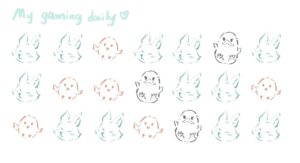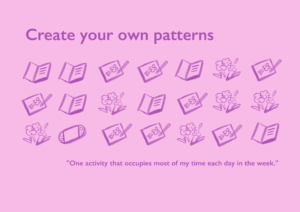Create your own Patterns

Reading Time: 3 minutesBefore starting the art task, learners need to prepare the following materials:
Daily Activities: What recurring activities are there, such as daily morning routines, weekly classes, or monthly routines?

Summary
Use pattern design to express multiple aspects of personal daily life, and create abstract and creative patterns through the method of pattern theory.
Create your own pattern
Introduction
Use pattern design to express multiple aspects of personal daily life, creating abstract and creative patterns through pattern theory methods.
In our daily lives, we experience a wide variety of emotions, activities, and events. Through pattern design we can express these aspects in a unique and creative way.
Pattern theory helps us understand the world in the language of patterns, capturing and expressing various patterns in a more vivid and understandable way. It’s like finding hidden patterns in real-world data. Inspired by this theory, you can explore the patterns of life in your own way and transform this creativity into unique patterns through artistic tasks.
Information
Before starting the art task, learners need to prepare the following materials:
Paper: Provide a large enough piece of paper, either plain paper, sketching paper, or drawing paper, to draw the pattern on.
Pens and Paints: Provide colored pens, syringes or watercolor paints in a variety of colors so learners can add color to their designs. Black pens are also acceptable
Other drawing tools: Encourage learners to try different drawing tools, such as colored pencils, oil pastels, etc., to increase the variety of patterns. Electronic drawings are also available.
Step One: Interpretation of Pattern Theory
Pattern theory is a theory that enables us to understand and express various patterns in the world in the form of patterns. Imagine as if we are using a unique language to describe what happens in our daily lives.
example:
For example, if you habitually drink a cup of coffee every morning, that habit is a lifestyle. Pattern theory encourages us not only to see a habit but to express it in terms of patterns. You can draw a pattern of a series of cups, each cup representing a coffee break throughout the day. If you happen to have a day without coffee, use another graphic to represent that day. In this way, through a simple pattern, you can vividly illustrate the pattern of your daily life. Pattern theory allows us to use this intuitive way to understand and communicate patterns in our lives.
Step 2: Think about patterns in your life
Guide learners to think about whether there are regular events, objects, activities, food, music, etc. in their lives.
Example questions:
Daily Activities: What recurring activities are there, such as daily morning routines, weekly classes, or monthly routines?
Favorite Food: Do you have any particular favorites, like a weekly go-to or a specific cooking style?
Musical genre: Is there a preferred musical genre in different situations? Do these musical choices form a pattern? For example, the order of pop, country, rap, jazz, etc. in a playlist you’ve listened to recently.
These questions will help you observe and identify patterns in their lives, providing rich material for subsequent pattern creation. By thinking about these rules, you can gain a deeper understanding of your own living habits and preferences, providing more personalized elements to your pattern creation.
Step 3: Express your personality with patterns
Inspiration: Encourage learners to use patterns to express the patterns in their lives they discovered in step two.
Teaching: Provides simple and easy-to-understand drawing methods, especially suitable for learners who are not good at drawing.
Teaching: Provides simple and easy-to-understand drawing methods, especially suitable for learners who are not good at drawing.
Specific steps:
Select pattern elements: Select specific lifestyle elements from the findings in step two, such as favorite foods, daily events, etc.
Simple Patterns: Think of easy peasy shapes and lines to show what you’ve picked. Like, a circle could be your morning coffee or use wavy, curvy lines that mimic the twisty, twirly nature of the noodles.
Color selection: Consider choosing a color for each pattern element to make the pattern more vivid. Coloring can be done using colored pens, stylus, or digital tools.
Personalized creation:Go wild with your imagination! Mix and match colors in your own style. Use non-traditional color combinations, such as orange grass or purple sky, to make the pattern more personal. It’s all about making your pattern shout ‘this is me!’.
If you don’t have a clue how to draw, use the link below for inspiration
https://www.art-is-fun.com/patterns-in-art
https://www.artyfactory.com/art_appreciation/visual-elements/pattern.htm
https://www.cowlingandwilcox.com/blog/post/46-creative-patterned-art-techniques
After completing your pattern design, name it and upload it to this website for community sharing. You can add your own impressions and comments on the creations of others on this platform:




